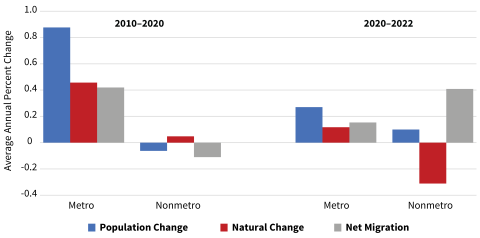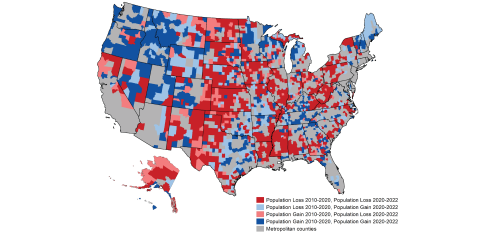Key Findings



Nonmetropolitan (rural) America gained population between April of 2020 and July of 2022 (Figure 1). In the preceding decade, rural areas lost population, both because more people left rural areas than moved to them and because births just minimally exceeded deaths. In contrast, the recent, modest rural population increase occurred because a significant net migration gain more than offset the growing excess of deaths over births fostered by the pandemic. These rural migration gains were widespread, occurring in 59 percent of all nonmetropolitan counties, compared to just 33 percent between 2010 and 2020.
More Rural Areas Are Growing, but Many Continue to Lose Population
Nearly 400 rural counties that lost population between 2010 and 2020 began to grow again between April 2020 and July 2022 (Figure 2). Migration gains fueled most of this growth. In addition, 460 counties that experienced growth in the prior decade continued to grow between 2020 and 2022. Much of the recent nonmetropolitan population increase accrued to high amenity recreational and retirement areas.1 Here migration gains from metropolitan areas were widespread because pandemic-related remote work arrangements gave people more residential flexibility.
Figure 1. Metropolitan and Nonmetropolitan Demographic Change, 2010 to 2022

Analysis: K.M. Johnson, Carsey School, University of New Hampshire. Source: 2010, 2020 Census and 2022 Population Estimates from U.S. Census Bureau.
Figure 2. Nonmetropolitan Population Change, 2010 to 2020 and 2020 to 2022

Analysis: K.M. Johnson, Carsey School, University of New Hampshire. Source: 2010, 2020 Census and 2022 Population Estimates from U.S. Census Bureau.
That rural migration was strong enough to produce population growth is especially surprising given that deaths outnumbered births—in part due to the pandemic—in 85 percent of all rural counties. Indeed, even though rural America as a whole gained population, most nonmetropolitan counties continued to lose population between 2020 and 2022. This included 200 counties that grew between 2010 and 2020, but lost population recently; in most cases because deaths exceeded births. Elsewhere in rural America, 920 counties with long histories of population decline continued to lose population. Many have suffered protracted migration losses that diminished their young adult populations to such an extent that few remain to have children, while deaths continue to accelerate among their aging populations.
Rural Demographic Trends and Health
Monitoring demographic trends informs planning for medical facilities, staffing, and access to specialized care, all issues that are important to the provision of rural care. Health needs are greater in areas with older populations and where pre-existing medical conditions are more prevalent. The rural population is older and has more pre-existing conditions than its urban counterparts. For instance, 33 percent of nonmetropolitan counties have populations with a high incidence of pre-existing health conditions compared to 11 percent of metropolitan counties.2 More than 26 percent of the nonmetropolitan population is 60 or older compared to 21 percent of the metropolitan population. In addition, higher levels of poverty, inequality, and food insecurity among rural populations increase their health risks. Access to health care is also a significant challenge in rural areas where there are fewer practitioners and facilities providing care. And, while timely access to comprehensive medical centers and specialized care is imperative for those with severe health conditions, lower rural population density means that such critical care is locally unavailable for many rural residents.
Looking ahead, it is unclear whether rural population gains will be sustained. As the pandemic wanes, rural deaths are diminishing, but there is no evidence of an upturn in births. A key question is how much of the recent rural migration gain is temporary, fostered by the residential flexibility of the pandemic, and how much represents a permanent change in residential preferences. It is imperative that we continue to monitor rural demographic trends so that health care planners and providers can best position themselves to address the unique challenges of providing healthcare to the rural population.
Methods and Data
This analysis uses data from the Census Bureau Population Estimates Program, April 1, 2020, to June 30, 2022. Although the Bureau uses the best data and algorithms available at the time of release to generate the data, they remain estimates. Concerns remain about the quality of the 2020 Census for subnational areas and populations, and about the impact of the Differential Privacy algorithms on its accuracy. A pre-existing health conditions index was calculated using estimates of the proportion of the population over age 18 who have the following health conditions: obesity, diabetes, lung disease (COPD), heart disease, kidney disease, and multiple chronic conditions, using data from the Centers for Disease Control and Prevention. Counties are the unit of analysis and are classified as nonmetropolitan (rural) and metropolitan (urban) based on the OMB 2018 Metropolitan Definition. The terms rural and nonmetropolitan are used interchangeably here as are the terms urban and metropolitan.
Endnotes
- Carson, Jess, Sarah Boege, and Libby Schwaner. 2023. “A Descriptive Study of Covid-Era Movers to the Northern Forest Region.” National Issue Brief No. 173. Durham, NH: Carsey School of Public Policy. https://carsey.unh.edu/publication/retaining-residents-is-important-to-new-hampshires-future
- Johnson, Kenneth M. 2020. “Health Conditions and an Older Population Increase COVID-19 Risks in Rural America.” National Issue Brief No. 150. Durham, NH: Carsey School of Public Policy. https://carsey.unh.edu/publication/health-conditions-older-population-COVID-19-Risks-Rural-America
About the Author

Kenneth M. Johnson is senior demographer at the Carsey School of Public Policy, professor of sociology at the University of New Hampshire, and an Andrew Carnegie Fellow. He is also a researcher at the NH Agricultural Experiment Station, and this research has been supported by the station through joint funding from the USDA National Institute of Food and Agriculture (under Hatch-Multistate project W-5001, award number 7003437) and the state of New Hampshire. The opinions are his and not those of the sponsoring organizations. The GIS work of Barb Cook is gratefully acknowledged.